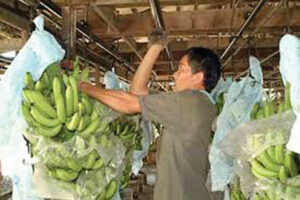THE PHILIPPINES is expected to book savings worth $189 million on banana exports over five years as the Philippines-South Korea free trade agreement (FTA) comes into force, the Department of Trade and Industry (DTI) said.
Export Marketing Bureau Director Bianca Pearl R. Sykimte said that the FTA will immediately reduce tariffs for Philippine banana exports by 6 percentage points this year.
“And that will be 12 percentage points by Jan. 1, 2025. Because when we implement FTAs, year 1 will always be the date of entry into force, and year 2 will always be Jan. 1,” she told reporters in an online briefing last week.
“If we base it on Korea’s $210-million imports of bananas from us, approximately, we have $12.6 million in tariff savings per year because of the tariff reduction. By year 2, we will have over $25 million in tariff savings,” she added.
Trade Undersecretary Ceferino S. Rodolfo said that the FTA will reduce the Philippines’ tariff disadvantage against South Korea’s other FTA partners.
“For example, Vietnam. By next year, Vietnam will have 0% duty on its bananas shipped to Korea. For us, that is 30% without the FTA,” Mr. Rodolfo said.
In 2012, the Philippines used to account for 98.2% of South Korea’s banana imports. However, this fell to 69.1% last year after other countries secured lower tariffs through FTAs.
The DTI reported that Costa Rica, Honduras, Peru, and Vietnam enjoy zero duty on their banana exports to South Korea, while Australia and Panama are charged 6% and 8% tariffs on their banana exports.
Under the pre-FTA regime bananas from the Philippines and Cambodia are subject to a 30% tariff.
“Since it became zero-duty for some of our competitors, like Vietnam, Costa Rica, and Peru, they were able to gain significant market share in the Korean market. So, we lost about 29% of the market,” Ms. Sykimte said.
Aside from bananas, she said that there will also be gains in other industries such as machinery, transport equipment, and garments.
The DTI estimates that the Philippines’ $9 million worth of machinery and transport equipment exports will be subject to tariff elimination in five to 10 years, while its $9-million exports of garments will be subject to tariff elimination in three years.
Asked if the tariff savings will affect prices of goods from Korea, Ms. Sykimte said: “It would depend on the business model involved — if they pass the savings on to the supply chain to charge the consumer less,” she said.
Mr. Rodolfo said that the level of competition in the Philippine consumer market will also be a factor on whether the tariff savings will be reflected in the prices of goods.
“In the first place, the tariff for all of the products where the Philippines gave concessions is already low, as they are also covered under the ASEAN-Korea FTA and the Regional Comprehensive Economic Partnership,” he said.
“I think most of them have 5% duty. So, if they get lower tariffs, it will only have a minimal impact. If there will be tariff savings, I think they will pass it on to the consumers,” he added. — Justine Irish D. Tabile

